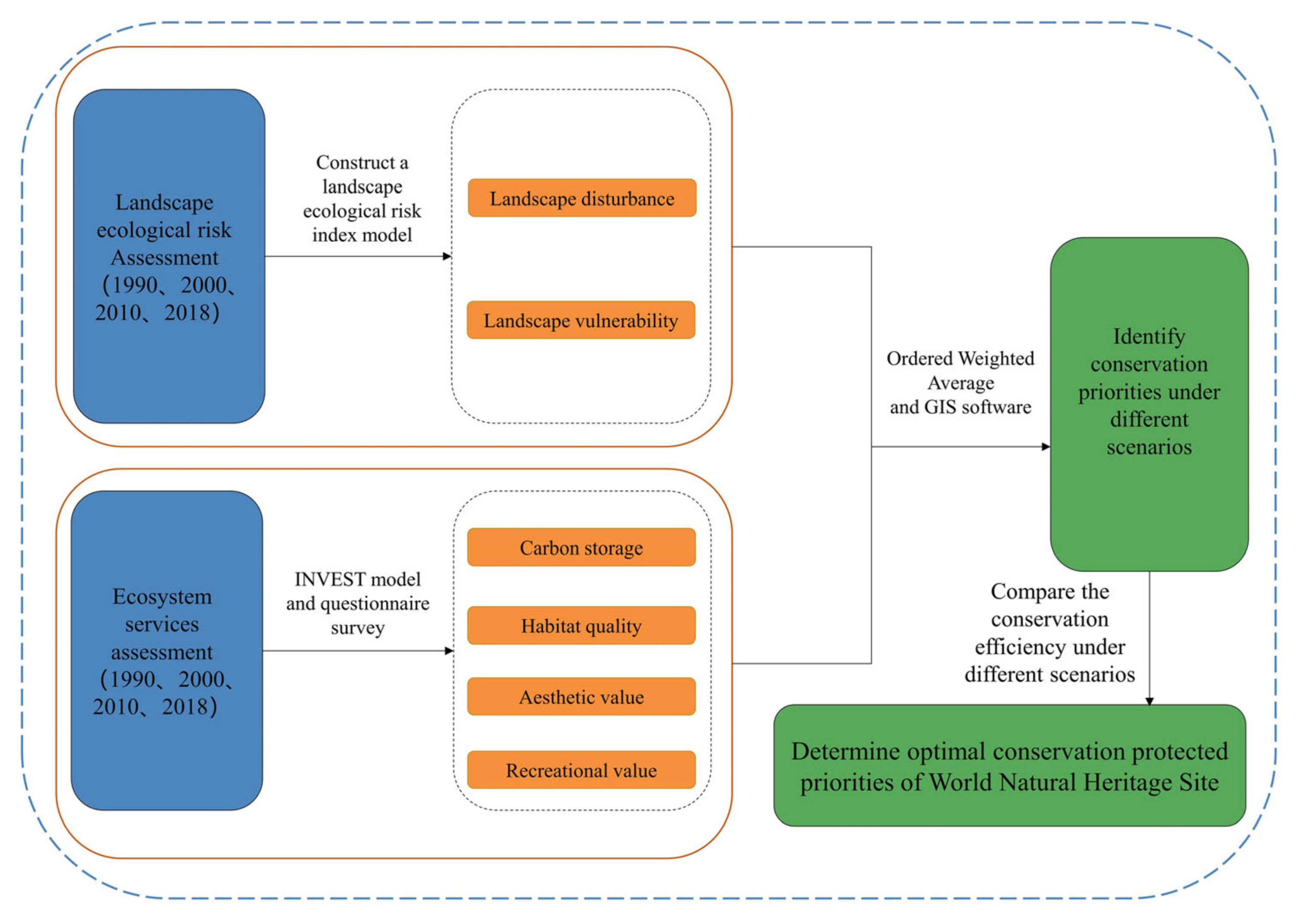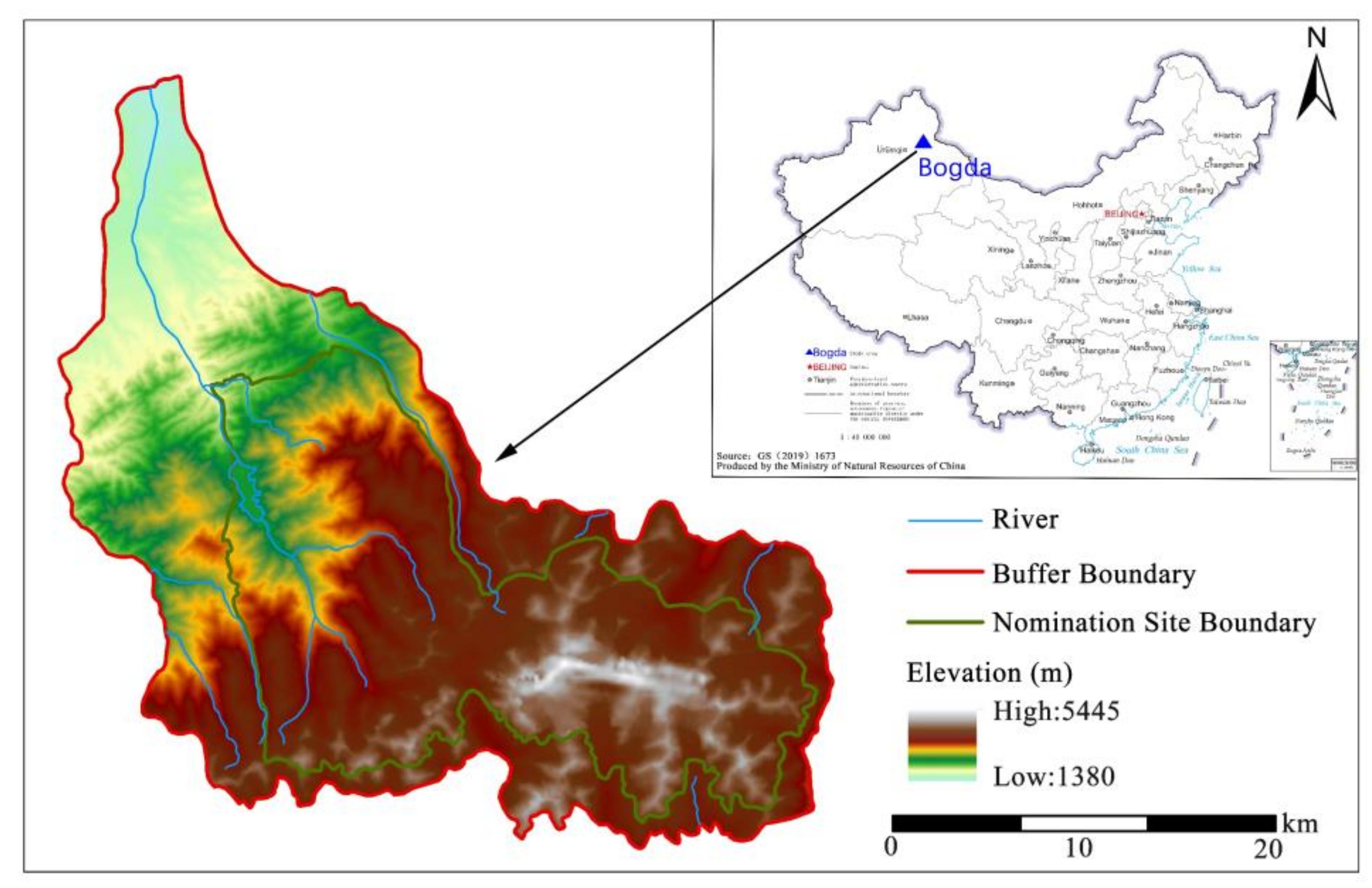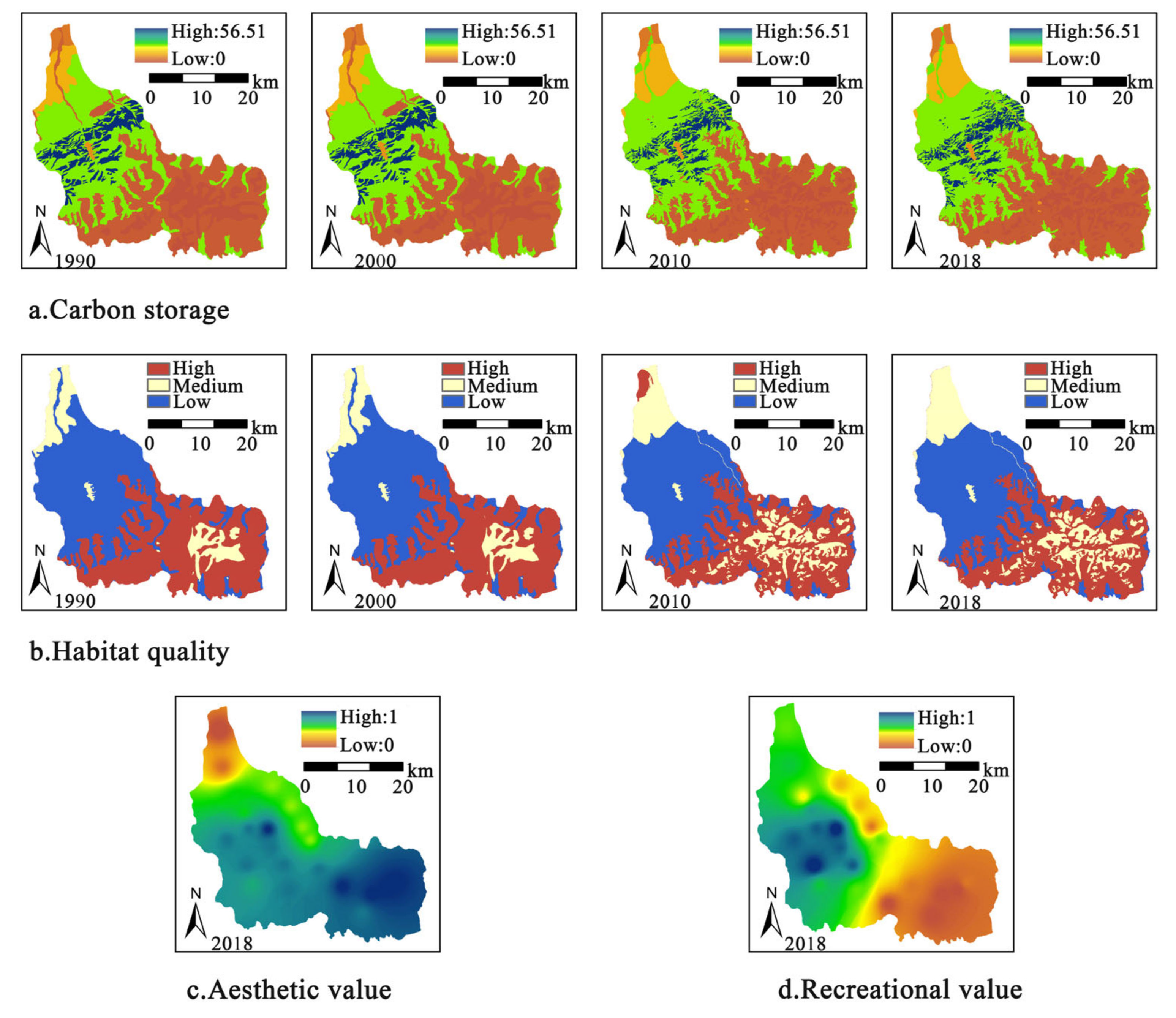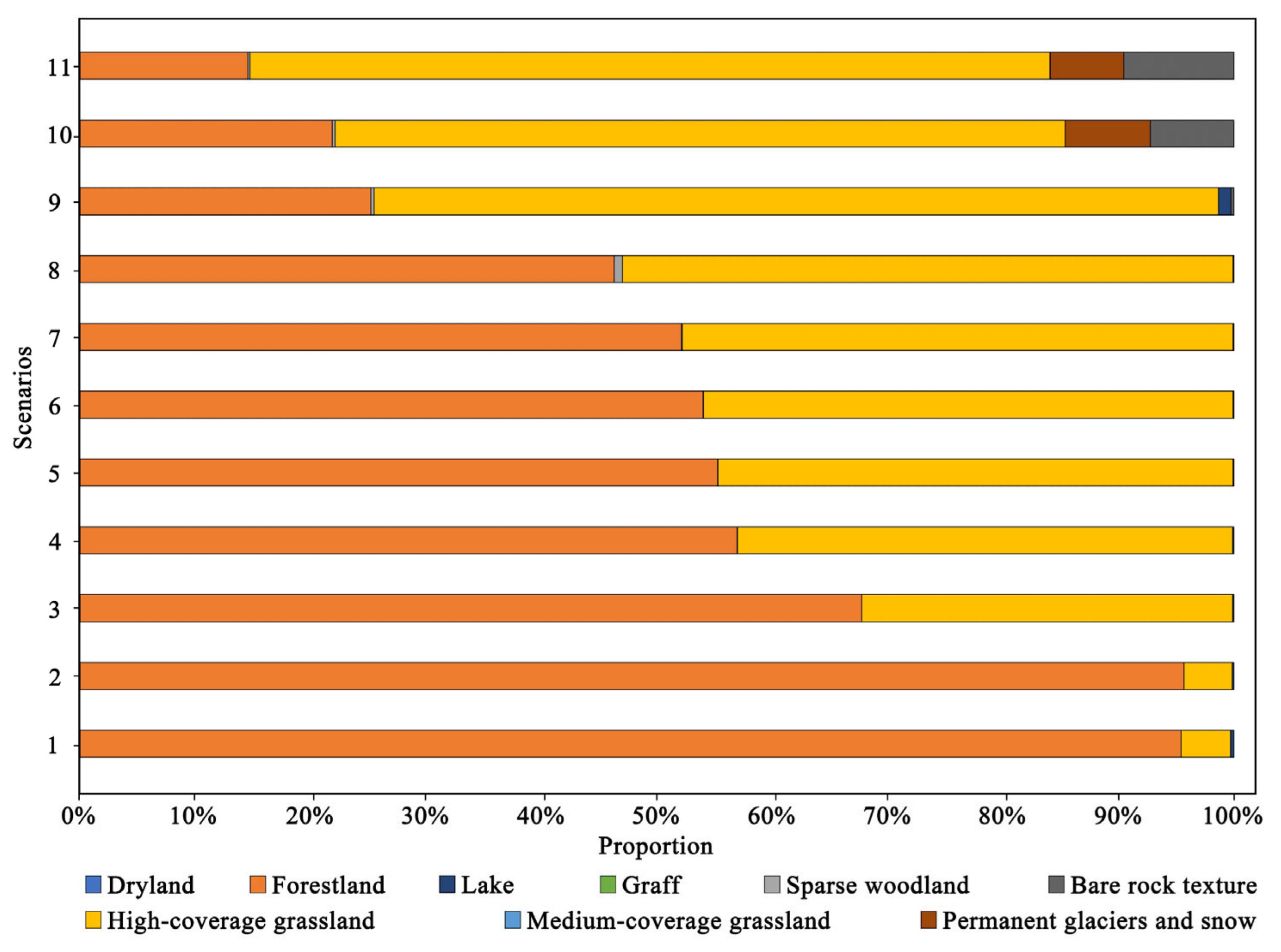Identification of Priority Conservation Areas for Natural Heritage Sites Integrating Landscape Ecological Risks and Ecosystem Services: A Case Study in the Bogda, China
Abstract
:1. Introduction
2. Materials and Methods
2.1. Study Framework
2.2. Study Area
2.3. Data Sources
2.4. Assessment of Landscape Ecological Risk
2.4.1. Division of Assessment Units
2.4.2. Construction of Landscape Ecological Risk Index
- (1)
- Landscape disturbance index
- (2)
- Landscape vulnerability index
- (3)
- Landscape ecological risk index
2.5. Quantification of Ecosystem Services
2.5.1. Carbon Storage
2.5.2. Habitat Quality
2.5.3. Aesthetic Value and Recreational Value
2.6. Selection of Optimal Conservation Priorities
2.6.1. OWA Algorithm
2.6.2. Selection of the Optimal Conservation Priorities
3. Results
3.1. Spatiotemporal Changes of Landscape Ecological Risk
3.2. Spatiotemporal Changes of Ecosystem Services
3.2.1. Carbon Storage
3.2.2. Habitat Quality
3.2.3. Aesthetic Value and Recreation Value
3.3. Conservation Priorities under Different Scenarios
3.4. Conservation Efficiency under Different Scenarios and the Optimal Priority Conservation Area
4. Discussion
4.1. Spatiotemporal Changes of Landscape Ecological Risk
4.2. Spatiotemporal Changes of Ecosystem Services
4.3. Identification of Conservation Priorities for World Natural Heritage Sites
4.4. Conservation Priorities under Different Scenarios
5. Conclusions
Author Contributions
Funding
Institutional Review Board Statement
Informed Consent Statement
Data Availability Statement
Acknowledgments
Conflicts of Interest
References
- Shi, H.; Han, F.; Liu, Q.; Wang, Z.; Zhao, H. Conservation Value of World Natural Heritage Sites’ Outstanding Universal Value via Multiple Techniques—Bogda, Xinjiang Tianshan. Sustainability 2019, 11, 5953. [Google Scholar] [CrossRef] [Green Version]
- Wang, Z.; Yang, Z.; Du, X. Analysis on the threats and spatiotemporal distribution pattern of security in World Natural Heritage Sites. Environ. Monit. Assess. 2015, 187, 4143. [Google Scholar] [CrossRef]
- Makino, M.; Sakurai, Y. Adaptation to climate-change effects on fisheries in the Shiretoko World Natural Heritage area, Japan. ICES J. Mar. Sci. 2012, 69, 1134–1140. [Google Scholar] [CrossRef] [Green Version]
- Manhães, A.P.; Loyola, R.; Mazzochini, G.; Ganade, G.; Oliveira-Filho, A.T.; Carvalho, A.R. Low-cost strategies for protecting ecosystem services and biodiversity. Biol. Conserv. 2018, 217, 187–194. [Google Scholar] [CrossRef]
- Wang, Z.; Yang, Z.; Shi, H.; Han, L. Effect of forest connectivity on the dispersal of species: A case study in the Bogda World Natural Heritage Site, Xinjiang, China. Ecol. Indic. 2021, 125, 107576. [Google Scholar] [CrossRef]
- Watson, J.; Dudley, N.; Segan, D.B.; Hockings, M. The performance and potential of protected areas. Nature 2014, 515, 67–73. [Google Scholar] [CrossRef]
- Peng, J.; Wang, A.; Luo, L.; Liu, Y.; Li, H.; Hu, Y.; Meersmans, J.; Wu, J. Spatial identification of conservation priority areas for urban ecological land: An approach based on water ecosystem services. Land Degrad. Dev. 2019, 30, 683–694. [Google Scholar] [CrossRef] [Green Version]
- Huang, Z.; Bai, Y.; Alatalo, J.M.; Yang, Z. Mapping biodiversity conservation priorities for protected areas: A case study in Xishuangbanna Tropical Area, China. Biol. Conserv. 2020, 249, 108741. [Google Scholar] [CrossRef]
- Duarte, G.T.; Ribeiro, M.C.; Paglia, A.P. Ecosystem Services Modeling as a Tool for Defining Priority Areas for Conservation. PLoS ONE 2016, 11, e0154573. [Google Scholar] [CrossRef] [PubMed] [Green Version]
- Ramel, C.; Rey, P.-L.; Fernandes, R.; Vincent, C.; Cardoso, A.R.; Broennimann, O.; Pellissier, L.; Pradervand, J.-N.; Ursenbacher, S.; Schmidt, B.R.; et al. Integrating ecosystem services within spatial biodiversity conservation prioritization in the Alps. Ecosyst. Serv. 2020, 45, 101186. [Google Scholar] [CrossRef]
- Faleiro, F.V.; Loyola, R.D. Socioeconomic and political trade-offs in biodiversity conservation: A case study of the Cerrado Biodiversity Hotspot, Brazil. Divers. Distrib. 2013, 19, 977–987. [Google Scholar] [CrossRef]
- Qin, K.; Li, J.; Liu, J.; Yan, L.; Huang, H. Setting conservation priorities based on ecosystem services—A case study of the Guanzhong-Tianshui Economic Region. Sci. Total Environ. 2019, 650, 3062–3074. [Google Scholar] [CrossRef]
- Ma, S.; Wang, L.-J.; Zhu, D.; Zhang, J. Spatiotemporal changes in ecosystem services in the conservation priorities of the southern hill and mountain belt, China. Ecol. Indic. 2020, 122, 107225. [Google Scholar] [CrossRef]
- Mo, W.; Wang, Y.; Zhang, Y.; Zhuang, D. Impacts of road network expansion on landscape ecological risk in a megacity, China: A case study of Beijing. Sci. Total Environ. 2017, 574, 1000–1011. [Google Scholar] [CrossRef] [PubMed] [Green Version]
- Peng, J.; Zong, M.; Hu, Y.; Liu, Y.; Wu, J. Assessing Landscape Ecological Risk in a Mining City: A Case Study in Liaoyuan City, China. Sustainability 2015, 7, 8312–8334. [Google Scholar] [CrossRef] [Green Version]
- Li, S.; Xiao, W.; Zhao, Y.; Lv, X. Incorporating ecological risk index in the multi-process MCRE model to optimize the ecological security pattern in a semi-arid area with intensive coal mining: A case study in northern China. J. Clean. Prod. 2020, 247, 119143. [Google Scholar] [CrossRef]
- Gong, J.; Cao, E.; Xie, Y.; Xu, C.; Li, H.; Yan, L. Integrating ecosystem services and landscape ecological risk into adaptive management: Insights from a western mountain-basin area, China. J. Environ. Manag. 2020, 281, 111817. [Google Scholar] [CrossRef]
- Cui, L.; Zhao, Y.; Liu, J.; Han, L.; Ao, Y.; Yin, S. Landscape ecological risk assessment in Qinling Mountain. Geol. J. 2018, 53, 342–351. [Google Scholar] [CrossRef]
- Hou, M.; Ge, J.; Gao, J.; Meng, B.; Li, Y.; Yin, J.; Liu, J.; Feng, Q.; Liang, T. Ecological Risk Assessment and Impact Factor Analysis of Alpine Wetland Ecosystem Based on LUCC and Boosted Regression Tree on the Zoige Plateau, China. Remote Sens. 2020, 12, 368. [Google Scholar] [CrossRef] [Green Version]
- Xu, W.; Wang, J.; Zhang, M.; Li, S. Construction of landscape ecological network based on landscape ecological risk assessment in a large-scale opencast coal mine area. J. Clean. Prod. 2021, 286, 125523. [Google Scholar] [CrossRef]
- Wei, H.; Liu, H.; Xu, Z.; Ren, J.; Lu, N.; Fan, W.; Zhang, P.; Dong, X. Linking ecosystem services supply, social demand and human well-being in a typical mountain-oasis-desert area, Xinjiang, China. Ecosyst. Serv. 2018, 31, 44–57. [Google Scholar] [CrossRef]
- Chen, L.; Pei, S.; Liu, X.; Qiao, Q.; Liu, C. Mapping and analysing tradeoffs, synergies and losses among multiple ecosystem services across a transitional area in Beijing, China. Ecol. Indic. 2021, 123, 107329. [Google Scholar] [CrossRef]
- Leemans, R.; De Groot, R.S. Millennium Ecosystem Assessment: Ecosystems and Human Well-Being: A Framework for Assessment; Island Press: Washington, DC, USA, 2005. [Google Scholar]
- Horcea-Milcu, A.-I.; Hanspach, J.; Abson, D.; Fischer, J. Cultural Ecosystem Services: A Literature Review and Prospects for Future Research. Ecol. Soc. 2013, 18, 44. [Google Scholar] [CrossRef] [Green Version]
- Assandri, G.; Bogliani, G.; Pedrini, P.; Brambilla, M. Beautiful agricultural landscapes promote cultural ecosystem services and biodiversity conservation. Agric. Ecosyst. Environ. 2018, 256, 200–210. [Google Scholar] [CrossRef]
- Fu, Y.; Xiong, K.; Zhang, Z. Ecosystem services and ecological compensation of world heritage: A literature review. J. Nat. Conserv. 2021, 60, 125968. [Google Scholar] [CrossRef]
- Isely, E.S.; Isely, P.; Seedang, S.; Mulder, K.; Thompson, K.; Steinman, A.D. Addressing the information gaps associated with valuing green infrastructure in west Michigan: INtegrated Valuation of Ecosystem Services Tool (INVEST). J. Great Lakes Res. 2010, 36, 448–457. [Google Scholar] [CrossRef]
- Yang, D.; Liu, W.; Tang, L.; Chen, L.; Li, X.; Xu, X. Estimation of water provision service for monsoon catchments of South China: Applicability of the InVEST model. Landsc. Urban Plan. 2019, 182, 133–143. [Google Scholar] [CrossRef]
- O’Neill, R.V.; Hunsaker, C.T.; Timmins, S.P.; Jackson, B.L.; Jones, K.B.; Riitters, K.H.; Wickham, J.D. Scale problems in reporting landscape pattern at the regional scale. Landsc. Ecol. 1996, 11, 169–180. [Google Scholar] [CrossRef]
- Steiger, R.; Scott, D.; Abegg, B.; Pons, M.; Aall, C. A critical review of climate change risk for ski tourism. Curr. Issues Tour. 2017, 22, 1343–1379. [Google Scholar] [CrossRef] [Green Version]
- Liu, Y.; Liu, Y.; Li, J.; Lu, W.; Wei, X.; Sun, C. Evolution of Landscape Ecological Risk at the Optimal Scale: A Case Study of the Open Coastal Wetlands in Jiangsu, China. Int. J. Environ. Res. Public Health 2018, 15, 1691. [Google Scholar] [CrossRef] [Green Version]
- Wang, B.; Ding, M.; Li, S.; Liu, L.; Ai, J. Assessment of landscape ecological risk for a cross-border basin: A case study of the Koshi River Basin, central Himalayas. Ecol. Indic. 2020, 117, 106621. [Google Scholar] [CrossRef]
- Li, K.; Wang, S.; Cao, M. Vegetation and soil carbon storage in China. Sci. China Ser. D Earth Sci. 2004, 47, 49–57. [Google Scholar] [CrossRef]
- Zhu, G.; Qiu, D.; Zhang, Z.; Sang, L.; Liu, Y.; Wang, L.; Zhao, K.; Ma, H.; Xu, Y.; Wan, Q. Land-use changes lead to a decrease in carbon storage in arid region, China. Ecol. Indic. 2021, 127, 107770. [Google Scholar] [CrossRef]
- Yang, J.; Ji, X.; Deane, D.C.; Wu, L.; Chen, S. Spatiotemporal Distribution and Driving Factors of Forest Biomass Carbon Storage in China: 1977–2013. Forests 2017, 8, 263. [Google Scholar] [CrossRef] [Green Version]
- Goldstein, J.H.; Caldarone, G.; Duarte, T.K.; Ennaanay, D.; Hannahs, N.; Mendoza, G.; Polasky, S.; Wolny, S.; Daily, G.C. Integrating ecosystem-service tradeoffs into land-use decisions. Proc. Natl. Acad. Sci. USA 2012, 109, 7565–7570. [Google Scholar] [CrossRef] [Green Version]
- Yang, Y. Evolution of habitat quality and association with land-use changes in mountainous areas: A case study of the Taihang Mountains in Hebei Province, China. Ecol. Indic. 2021, 129, 107967. [Google Scholar] [CrossRef]
- Lin, Y.-P.; Lin, W.-C.; Wang, Y.-C.; Lien, W.-Y.; Huang, T.; Hsu, C.-C.; Schmeller, D.; Crossman, N.D. Systematically designating conservation areas for protecting habitat quality and multiple ecosystem services. Environ. Model. Softw. 2017, 90, 126–146. [Google Scholar] [CrossRef]
- Wu, L.; Sun, C.; Fan, F. Estimating the Characteristic Spatiotemporal Variation in Habitat Quality Using the InVEST Model—A Case Study from Guangdong–Hong Kong-Macao Greater Bay Area. Remote Sens. 2021, 13, 1008. [Google Scholar] [CrossRef]
- Hermes, J.; Albert, C.; von Haaren, C. Assessing the aesthetic quality of landscapes in Germany. Ecosyst. Serv. 2018, 31, 296–307. [Google Scholar] [CrossRef]
- Gosal, A.; Ziv, G. Landscape aesthetics: Spatial modelling and mapping using social media images and machine learning. Ecol. Indic. 2020, 117, 106638. [Google Scholar] [CrossRef]
- Tribot, A.-S.; Deter, J.; Mouquet, N. Integrating the aesthetic value of landscapes and biological diversity. Proc. R. Soc. B Boil. Sci. 2018, 285, 20180971. [Google Scholar] [CrossRef] [PubMed]
- Van der Zanden, E.H.; Verburg, P.; Mucher, S. Modelling the spatial distribution of linear landscape elements in Europe. Ecol. Indic. 2013, 27, 125–136. [Google Scholar] [CrossRef]
- Liu, W.-Y.; Fang, B.-S.; Hsieh, C.-M. Evaluating the Recreation Value of Alishan National Forest Recreation Area in Taiwan. Forests 2021, 12, 1245. [Google Scholar] [CrossRef]
- Zhou, L.; Guan, D.; Huang, X.; Yuan, X.; Zhang, M. Evaluation of the cultural ecosystem services of wetland park. Ecol. Indic. 2020, 114, 106286. [Google Scholar] [CrossRef]
- Kang, L.; Yang, Z.; Han, F. The Impact of Urban Recreation Environment on Residents’ Happiness—Based on a Case Study in China. Sustainability 2021, 13, 5549. [Google Scholar] [CrossRef]
- Zhang, L.; Fu, B.; Lü, Y.; Zeng, Y. Balancing multiple ecosystem services in conservation priority setting. Landsc. Ecol. 2014, 30, 535–546. [Google Scholar] [CrossRef]
- Li, X.; Yu, X.; Wu, K.; Feng, Z.; Liu, Y.; Li, X. Land-use zoning management to protecting the Regional Key Ecosystem Services: A case study in the city belt along the Chaobai River, China. Sci. Total Environ. 2021, 762, 143167. [Google Scholar] [CrossRef]
- Yager, R. On ordered weighted averaging aggregation operators in multicriteria decisionmaking. IEEE Trans. Syst. Man, Cybern. 1988, 18, 183–190. [Google Scholar] [CrossRef]
- Liu, Q.; Yang, Z.; Wang, F. Conservation Policy-Community Conflicts: A Case Study from Bogda Nature Reserve, China. Sustainability 2017, 9, 1291. [Google Scholar] [CrossRef] [Green Version]
- Du, W.; Shi, N.; Xu, L.; Zhang, S.; Ma, D.; Wang, S. Monitoring the Spatiotemporal Difference in Glacier Elevation on Bogda Mountain from 2000 to 2017. Int. J. Environ. Res. Public Health 2021, 18, 6374. [Google Scholar] [CrossRef]
- Hashimotio, T.; Kojima, K.; Tange, T.; Sasaki, S. Changes in carbon storage in fallow forests in the tropical lowlands of Borneo. For. Ecol. Manag. 2000, 126, 331–337. [Google Scholar] [CrossRef]
- Yang, K.; Guan, D. Changes in forest biomass carbon stock in the Pearl River Delta between 1989 and 2003. J. Environ. Sci. 2008, 20, 1439–1444. [Google Scholar] [CrossRef]
- Yohannes, H.; Soromessa, T.; Argaw, M.; Dewan, A. Spatio-temporal changes in habitat quality and linkage with landscape characteristics in the Beressa watershed, Blue Nile basin of Ethiopian highlands. J. Environ. Manag. 2021, 281, 111885. [Google Scholar] [CrossRef]
- Ha, S.; Yang, Z. Evaluation for landscape aesthetic value of the Natural World Heritage Site. Environ. Monit. Assess. 2019, 191, 483. [Google Scholar] [CrossRef]
- Kaplan, R.; Kaplan, S.J. The experience of nature—A psychological perspective. Nerv. Ment. Dis. 1991, 179, 704. [Google Scholar] [CrossRef]
- Peña, L.; Casado-Arzuaga, I.; Onaindia, M. Mapping recreation supply and demand using an ecological and a social evaluation approach. Ecosyst. Serv. 2015, 13, 108–118. [Google Scholar] [CrossRef]
- Casado-Arzuaga, I.; Onaindia, M.; Madariaga, I.; Verburg, P.H. Mapping recreation and aesthetic value of ecosystems in the Bilbao Metropolitan Greenbelt (northern Spain) to support landscape planning. Landsc. Ecol. 2013, 29, 1393–1405. [Google Scholar] [CrossRef]
- Wang, R.; Zhao, J.; Liu, Z. Consensus in visual preferences: The effects of aesthetic quality and landscape types. Urban For. Urban Green. 2016, 20, 210–217. [Google Scholar] [CrossRef]
- Kalinauskas, M.; Mikša, K.; Inácio, M.; Gomes, E.; Pereira, P. Mapping and assessment of landscape aesthetic quality in Lithuania. J. Environ. Manag. 2021, 286, 112239. [Google Scholar] [CrossRef] [PubMed]






| Scenario | Risk | Tradeoff | |||||
|---|---|---|---|---|---|---|---|
| 1 | 0 | 0 | 0 | 0 | 1 | 0 | 0 |
| 2 | 0 | 0 | 0.03 | 0.33 | 0.63 | 0.10 | 0.37 |
| 3 | 0 | 0.04 | 0.18 | 0.32 | 0.46 | 0.20 | 0.57 |
| 4 | 0.04 | 0.12 | 0.2 | 0.28 | 0.36 | 0.30 | 0.71 |
| 5 | 0.12 | 0.16 | 0.2 | 0.24 | 0.28 | 0.40 | 0.86 |
| 6 | 0.2 | 0.2 | 0.2 | 0.2 | 0.2 | 0.50 | 1 |
| 7 | 0.28 | 0.24 | 0.2 | 0.16 | 0.12 | 0.60 | 0.86 |
| 8 | 0.36 | 0.28 | 0.2 | 0.12 | 0.04 | 0.70 | 0.71 |
| 9 | 0.46 | 0.32 | 0.18 | 0.04 | 0 | 0.80 | 0.57 |
| 10 | 0.63 | 0.33 | 0.03 | 0 | 0 | 0.90 | 0.37 |
| 11 | 1 | 0 | 0 | 0 | 0 | 1 | 0 |
| Scenario | LER | Carbon Storage | Habitat Quality | Aesthetic | Recreation | Average |
|---|---|---|---|---|---|---|
| 1 | 1.28 | 3.43 | 1.95 | 1.04 | 1.22 | 1.78 |
| 2 | 1.13 | 0.85 | 1.06 | 0.93 | 0.99 | 0.99 |
| 3 | 1.16 | 2.91 | 1.96 | 1.03 | 1.21 | 1.65 |
| 4 | 0.95 | 1.74 | 1.96 | 0.98 | 1.10 | 1.35 |
| 5 | 1.14 | 2.68 | 1.96 | 1.04 | 1.22 | 1.61 |
| 6 | 1.14 | 2.66 | 1.96 | 1.04 | 1.22 | 1.60 |
| 7 | 1.13 | 2.62 | 1.96 | 1.04 | 1.22 | 1.59 |
| 8 | 1.10 | 2.50 | 1.96 | 1.03 | 1.21 | 1.56 |
| 9 | 1.02 | 2.11 | 1.95 | 1.02 | 1.14 | 1.45 |
| 10 | 1.07 | 1.83 | 1.71 | 1.03 | 1.08 | 1.35 |
| 11 | 1.03 | 1.68 | 1.68 | 1.00 | 1.05 | 1.29 |
Publisher’s Note: MDPI stays neutral with regard to jurisdictional claims in published maps and institutional affiliations. |
© 2022 by the authors. Licensee MDPI, Basel, Switzerland. This article is an open access article distributed under the terms and conditions of the Creative Commons Attribution (CC BY) license (https://creativecommons.org/licenses/by/4.0/).
Share and Cite
Wang, T.; Chen, X.; Zheng, X.; Lu, Y.; Han, F.; Yang, Z. Identification of Priority Conservation Areas for Natural Heritage Sites Integrating Landscape Ecological Risks and Ecosystem Services: A Case Study in the Bogda, China. Int. J. Environ. Res. Public Health 2022, 19, 2044. https://doi.org/10.3390/ijerph19042044
Wang T, Chen X, Zheng X, Lu Y, Han F, Yang Z. Identification of Priority Conservation Areas for Natural Heritage Sites Integrating Landscape Ecological Risks and Ecosystem Services: A Case Study in the Bogda, China. International Journal of Environmental Research and Public Health. 2022; 19(4):2044. https://doi.org/10.3390/ijerph19042044
Chicago/Turabian StyleWang, Tian, Xiaodong Chen, Xin Zheng, Yayan Lu, Fang Han, and Zhaoping Yang. 2022. "Identification of Priority Conservation Areas for Natural Heritage Sites Integrating Landscape Ecological Risks and Ecosystem Services: A Case Study in the Bogda, China" International Journal of Environmental Research and Public Health 19, no. 4: 2044. https://doi.org/10.3390/ijerph19042044
APA StyleWang, T., Chen, X., Zheng, X., Lu, Y., Han, F., & Yang, Z. (2022). Identification of Priority Conservation Areas for Natural Heritage Sites Integrating Landscape Ecological Risks and Ecosystem Services: A Case Study in the Bogda, China. International Journal of Environmental Research and Public Health, 19(4), 2044. https://doi.org/10.3390/ijerph19042044






